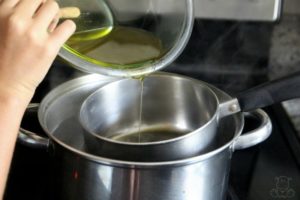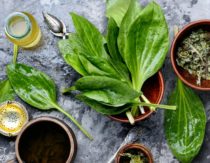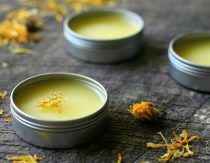
It’s a weed . . it’s a banana . . . no . . . it’s . . . plantain – the most useful “weed” in your backyard!
If you’ve ever secretly wanted to be Dr. Quinn, Medicine Woman, give this a try: The next time your little one comes to you with an owie – say a wasp sting on her eyebrow for example – kiss it until the stinging stops. Then go on your way, completely forgetting about it until she wakes up from a nap looking like she went three rounds with Rocky Balboa.
Oops. So, in this purely theoretical situation, here’s what you would do next:
Head out into the backyard and begin gathering “medicine” with your little one. Relish the way she takes it in with wide eyes. Now pick a leaf, pop it into your mouth, and chew – then stick the green wad right on the sting.
What, no???
Well, for the record, it works. But if you want something a bit more, uh, not gross, you can use the plantain salve recipe below.

Plantain Leaf – A Versatile “First Aid” Ointment
If you only know one plant in the wild, it should really be plantain – the herb, not the banana.
It grows all over the country, and prefers packed dirt. If you have a dirt driveway, or if you hike on a hard-packed trail, you’ve certainly seen it. Good thing it lives just about everywhere, too, because you can use it for absolutely everything!
Plantain is sometimes called the “band aid” plant because – thanks to the presence of iridoids – it has a very soothing, anti-inflammatory effect on skin. (1) It also contains aglycone and aucubigenin – which have documented antibacterial activity – and allantoin, which supports skin healing. (2) (3)
Plantain is considered helpful for:
- Bee/wasp stings
- Mosquito bites and other bug bites
- Poison ivy/poison oak/sumac (here are some other home remedies that can ease discomfort)
- Eczema
- Psoriasis
- Sunburn
- Diaper rash
The salve recipe below also makes a lovely all-purpose moisturizer and lip balm.
Backyard Treasure Hunting: How to Find Plantain
Years ago, when the theoretical situation above was a little less theoretical, I filmed the video below with my daughter identifying broadleaf plantain (Plantago major).
Narrowleaf plantain (Plantago lanceolata) can also be used in the recipe below – you can find instructions for identifying it here.
If you don’t have access to an area that has not been sprayed with pesticides, you can buy dried plantain. Or if you prefer not to make your own, you can find plantain salve with goldenseal here.
DIY Plantain Salve Recipe
Equipment
- mason jar with lid
- Crockpot
- cheesecloth
- turkey baster
Ingredients
- 2 cups fresh plantain leaves that were gathered from an area that has not been sprayed with chemicals OR 5-8 rounded tablespoons dried plantain leaves
- 1 cup carrier oil such as olive, coconut, or avocado
- 1 ounce beeswax pearls by weight, or about 3 tablespoons
- 36-72 drops tea tree or lavender essential oil
Instructions
If you're using fresh leaves, start with step one. If you're using dried leaves, start with step four.
- Harvest your leaves on a dry, sunny day. Pull off any parts that look sick or diseased and brush off dirt with a dry cloth if needed. Arrange leaves in a single layer on a clean, dry surface (best lined with a towel even though I forgot to take a photo after putting it down) and allow them to air dry for 2-3 days. When the leaves are dry and crisp, start step 3.
- Chop the leaves or place them in a food processor and pulse a few times until they are coarsely chopped.
- Place ground leaves in a clean, dry pint mason jar and cover with oil. The oil should completely cover the leaves.
- Cover the jar with a lid. Place a kitchen towel in the bottom of your crockpot and place your jars inside. Add enough water to cover about half the jar and set to low heat. I recommend the lowest setting possible, which is the "keep warm" setting on the slow cooker I use. Leave the slow cooker uncovered and allow the oil to infuse for 2-6 hours, adding water if needed to keep the slow cooker basin from drying out. Give it a shake (to help the plantain infuse faster) if you think about it whenever you walk by. (In the photo there are two jars because I was making a double batch.)
- Remove the jar from the crockpot and strain the oil through cheesecloth or a fine mesh sieve. Let the oil sit for several hours. If there is any water in the oil (from the plantain leaves) it will collect in the bottom of the jar. If there is any water in the oil, use a turkey baster (if you have one) to siphon the infused oil off the top, leaving the water behind. If you don’t have a turkey baster, carefully pour the oil off the top.
- Give the cheesecloth a good squeeze to extract as much of the plantain-infused oil as possible.
- Now that your plantain oil is ready, gently heat the beeswax in a double boiler. When it is melted, add the plantain oil while taking care not to pour in any water that may have collected at the bottom of the jar. Stir until thoroughly mixed. If you're adding essential oils, wait until the mixture has cooled a bit and then stir them in.
- Pour your salve into a clean, dry container and allow to cool. Now you're ready for the next bug attack, bee sting, or brush with poison ivy!
Video
A Note On Shelf Life
Water can cause infused oils to spoil, which is why my method calls for gently drying the plantain leaves before adding them to the carrier oil.
According to renowned herbalist Susun Weed, “Infused oils in an olive oil base resist rancidity at cool room temperature for several years.” (4)
Frequently Asked Questions
There are two main factors that affect the color of the finished salve. They are:
Carrier oil color – Dark green carrier oils will yield a darker salve, while lighter ones will yield light green or yellow. Coconut oil tends to yield light yellow or white.
Heat setting – When the plantain oil is infused with no heat or very low heat it tends to yield a different color than medium heat. This also applies to the amount of heat that is used when blending the infused oil and wax.
Yes! I suggest replacing a tablespoon or more of dried plantain with either calendula, dandelion or comfrey.
It can be used with cloth diapers but may decrease absorbency over time. If that happens the diapers will need to be stripped.
Want more research-backed natural remedies?
No problem, I’ve created a free ebook for you – Kitchen Apothecary: 25+ Natural Remedies Using Ingredients From Your Pantry – as a gift for signing up for my newsletter. You’ll also get updates when I post about safe essential oils for pregnant/breastfeeding mamas, exclusive gifts and coupons (I was able to give away a jar of free coconut oil to anyone who wanted it recently!), plus other goodies.
Sign up using the form below.
Sources:
1. Villasenor, Irene (2007) Bioactivities of Iridoids. Retrieved from http://www.eurekaselect.com/66121/article/bioactivities-iridoids
2. Drugs.com: Plantago. Retrieved from https://www.drugs.com/npp/plantain.html#ref2
3. Winston, David (2003) Herbal Therapeutics: Specific Indications for Herbs & Herbal Formulas (8th Edition)











